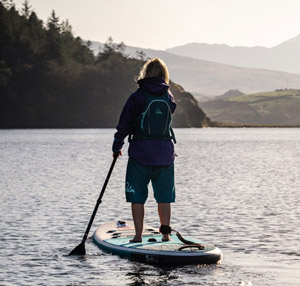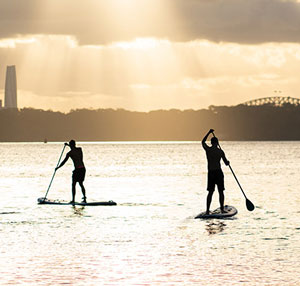Beginner's Guide To Yoga Paddle Boarding
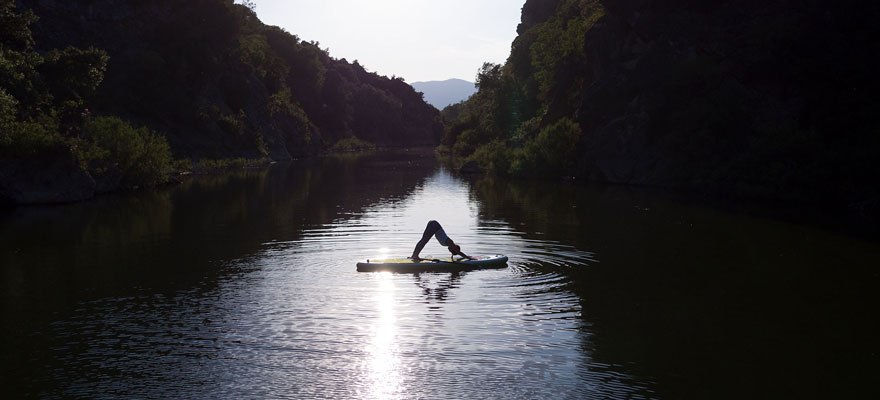
Image source: Red Paddle Co
Yoga paddle boarding, or SUP yoga for short, has seen a massive surge in popularity in recent years. It's not just a fun pastime for a warm summer's day, but it’s also a great outdoor workout that can have a significant positive effect on your physical and mental health. Whether you’re an experienced paddler or yogi, or you’ve never tried either activity before, SUP yoga is a fantastic way to challenge yourself and spend more time in nature.
But I bet you’re wondering what exactly does yoga paddle boarding entail and where can you try it? Keep reading to find out all the answers to your burning questions.
What is SUP yoga?
The name is a big giveaway, but, essentially, SUP yoga refers to the practice of modern yoga on top of a stand-up paddle board on a calm body of water. The outdoor setting is an essential aspect of the exercise and its benefits. Nature’s own soundtrack, fresh air, and beautiful surroundings help relax the body and mind.
The roots of paddle board yoga potentially go all the way back to surfers in 1940’s Hawaii, but SUP yoga as we know it today has only been around for ten years or so, originating in the US in the early 2010s. It emphasises mental focus, controlled breathing, and slow-paced flow sequences, drawing inspiration from popular yoga styles such as vinyasa flow and hatha.
The two main differences between paddle board yoga and on-land yoga are the pacing and what happens if you lose your balance. But the key is to not worry too much about falling in the water; it is likely to happen, so the best thing you can do is accept and embrace it as a part of the exercise. You don’t need any previous experience of either activity to join in on the fun and enjoy the benefits of SUP yoga.
What equipment do I need for yoga paddle boarding?
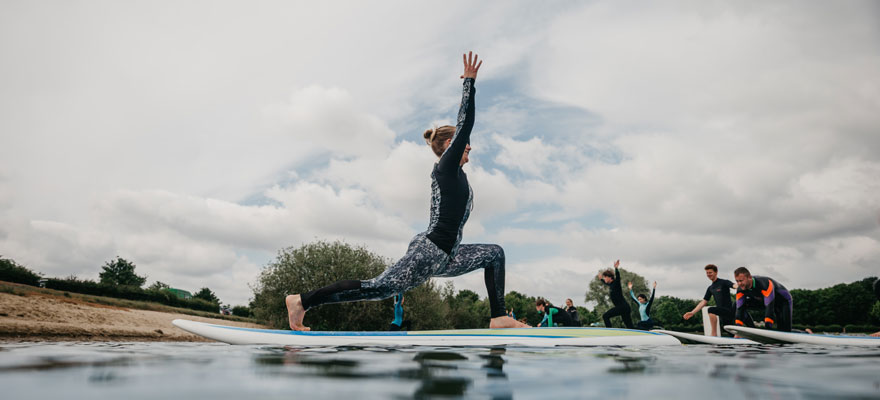
Image source: Joppe Spaa/Unsplash
Depending on where and when you’re hoping to do SUP yoga, you don’t necessarily need a load of kit. Usually, companies that offer paid classes provide a board, a paddle, and their chosen anchoring system as a part of your booking. But sometimes, you can get a discount on the price if you bring your own board, so anyone planning on attending regularly and hoping to do more paddling in general should consider purchasing one.
Here’s all the equipment needed for SUP yoga; the list is by no means exhaustive, but it provides a great baseline to get you started.
- SUP & paddle - Your own board and paddle are optional if you’re attending SUP yoga classes, but they’re a must if you want to go out and practice by yourself.
- Anchor or tether - To ensure your board isn’t entirely at the mercy of the current, it might be a good idea to anchor or tether it. It won’t make it completely stationary, but that’s part of the charm.
- Paddle strap - Not a must, but good to have. The paddle strap will ensure that you don’t lose your paddle. Bungees can also do the job.
- Comfortable clothing - It’s entirely up to you whether you wear a wetsuit, swimwear or activewear. Just bear in mind that there is a chance you might fall in the water, so only choose pieces of clothing that you don’t mind getting wet. The main thing is that you dress weather-appropriately and comfortably.
- Sandals, sliders or flip flops - Make sure to bring a pair of shoes that are also fine to get wet. You will probably do the yoga practice barefoot as it's easier to balance that way, so sandals and sliders are a popular option for their easy removal.
- Dry bag - If you want to bring any valuables with you when you practice SUP yoga, a dry bag is a lifesaver. You can attach it to your board for extra security.
- Water bottle - Just like for any exercise, you should always bring a good water bottle to stay hydrated while practising SUP yoga.
- Towel - Bring a packable travel towel and pop it in your dry bag in case you get wet, or lay it on top of your board for better traction under your hands and feet when you're doing the poses.
- PFD - Although you stay relatively stationary on the water while doing SUP yoga, it is still a good idea to wear a flotation device. If you’re worried about the PFD restricting your movement, choose an inflatable one that packs into a waist belt, allowing you to deploy it when needed.
How to choose a paddle board for SUP yoga?
You can technically practice yoga on any paddle board on the market, but certain features will make it a bit easier and more comfortable for you. All round boards tend to tick most of the boxes, and they’re practical for a wide range of paddle boarding activities from recreational fun to touring, so you’re not solely limited to yoga.
Here are some key features to look out for in a yoga paddle board.
Inflatable VS hard paddle board
Inflatable paddle boards are ideal for SUP yoga as they are more stable than hard boards. The added stability makes it easier for you to balance the board, allowing you to practice an extensive range of poses.
Longer deck pad
The purpose of the deck pad is to add traction and cushioning underfoot while paddling, but it is also ideal for practising yoga. Deck pads vary in shape and size from brand to brand and model to model. It doesn’t have to reach all the way from nose to tail to be suited for yoga, but a longer pad will improve comfort and flow.
Width
Wider boards also increase your stability on the water, so it’s best to avoid purchasing a narrow touring board if you mainly intend to use your board for SUP yoga or recreational paddling. Most all round paddle boards are the ideal width for practising yoga.
The O'Shea HDx or the Red Paddle Co Ride are some great examples from our summer 2021 range offering fantastic all round performance for paddling and SUP yoga.
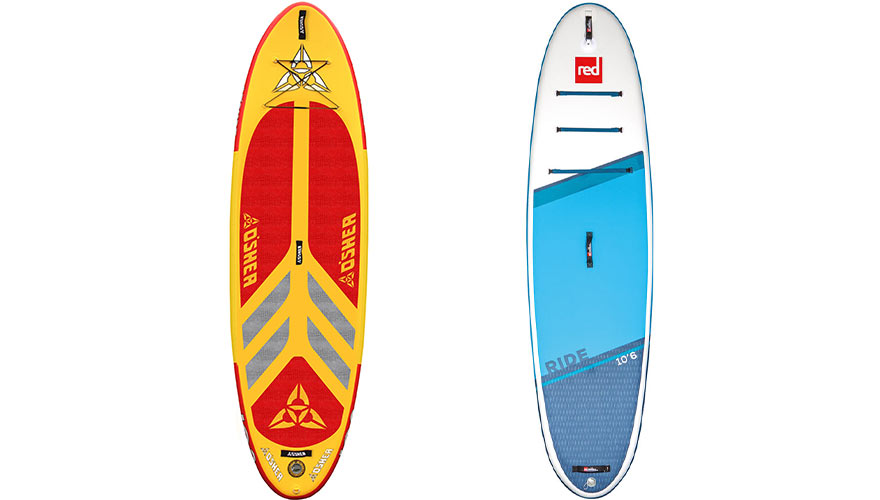
For more information on different types of paddle boards and how to choose the right one for your needs, check out our SUP Buying Guide.
What are the benefits?
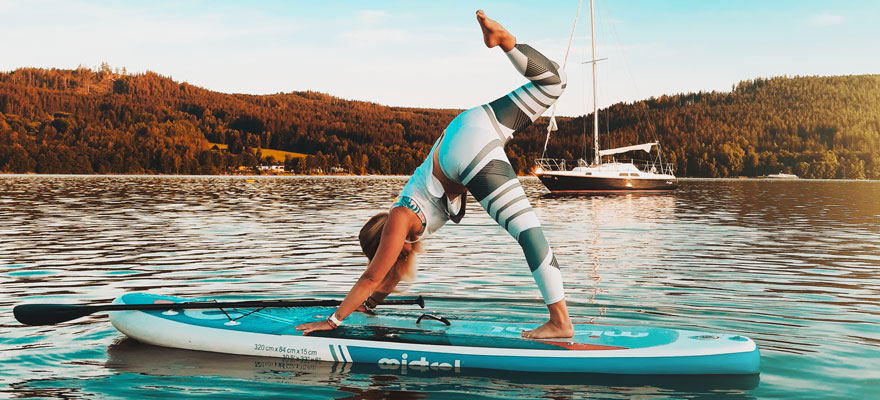
Image source: Daniel Frank/Unsplash
SUP yoga has a wide range of physical and mental health benefits as it combines the best of two different activities. You get to experience the positive effects of being in nature while doing some gentle exercise.
Stress relief
The combination of being in nature and practising yoga is the ultimate stress reliever. You get to leave your worries on the shore, listen to the sound of the flowing water, and focus on your breathing and movement. Understandably it can be challenging to reach that relaxed state at first if you're worried about falling in the water. But once you accept the risk and gain more experience, it will become less and less likely. If anything, a quick dip in the water during exercise can be refreshing.
Ultimately it doesn't matter how well you're doing the poses or whether you're standing up, because as long as you’re having fun, your stress levels will go down.
Improved balance
Yoga on its own is a fantastic balancing exercise, but once you do the same poses on a floating paddle board, you’re taking it to another level. An improved sense of balance has many benefits to various other sports and activities as well as everyday tasks.
Refined yoga technique
People who usually practice yoga on land have experienced rapid improvement once they also started practising on the water. Every movement that you make on a paddle board will have to be slower and more controlled than on solid ground. This means that you engage deeper muscles that will eventually help support your form better on land as well.
Enhanced paddling skills
If you’re hoping to become a better stand-up paddler, SUP yoga can also do just that. By improving your balance, strength, and board handling skills, it will help you take your paddling to the next level.
Confidence boost
Learning new skills tends to make us humans feel good about ourselves and boost our confidence. SUP yoga is an activity where people tend to make quick progress, which means that you can start to see improvement within a few sessions. So, if you want to see rapid progress and feel good about yourself, yoga paddle boarding is the ideal hobby for you.
Where can I do SUP yoga in the UK?
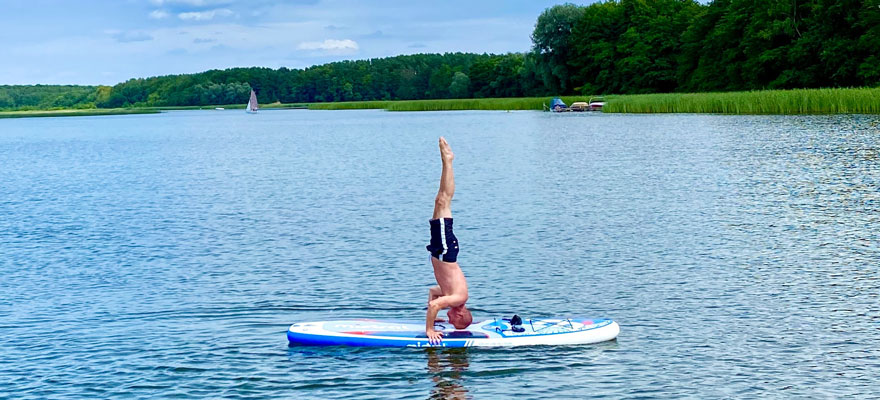
Image source: Matthias Patzuda/Unsplash
In theory, you can practise SUP yoga anywhere you can paddle, but you should avoid stationing your board somewhere that might disturb other water users. The most popular venues for SUP yoga tend to be calm bodies of water such as lakes and bays.
SUP yoga group sessions are the easiest way to get into the sport, especially if you have never done either yoga or paddle boarding before. The instructors will be happy to answer all of your questions regarding the equipment and the technique. You can find yoga paddle boarding classes all over the UK. The prices vary from £20 to £30 per class with equipment hire, but some places offer discounts for purchasing a pass or bringing your own board.
In the UK, many waterways require either a license or landowner’s permission for paddle boarding, and the same rule applies to SUP yoga as well. Even if you’re attending a class but bringing your own paddle board, it is your responsibility to ensure that you have a valid license where required. We’ve compiled all the information on permits here.
About the Author:Iida Ruokojärvi - Outdoor ExpertIida grew up in Finland where she was introduced to the outdoors at a very young age. Snowboarding has become second nature to her despite now living in a less snowy part of the world. Since moving to the UK, she rediscovered her love for hiking and continues to explore the British mountains and beyond. |

